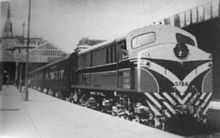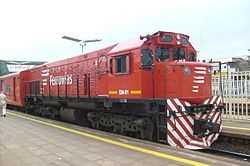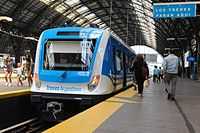Belgrano Norte Line
 Belgrano Norte Line | |
|---|---|
|
A train in Grand Bourg station. | |
| Overview | |
| Service type | Urban rail |
| Status | Operating |
| Locale | Buenos Aires Province |
| Predecessor | Córdoba Central Railway |
| First service | 1948 |
| Current operator(s) | Ferrovías |
| Former operator(s) | FEMESA |
| Ridership | 42 million [1] |
| Website | Official site |
| Route | |
| Start | Retiro |
| Stops | 22 |
| End | Villa Rosa |
| Distance travelled | 55 km |
| Average journey time | 80' |
| Service frequency | 10' |
| On-board services | |
| Class(es) | Standard class only |
| Baggage facilities | Overhead racks |
| Technical | |
| Track gauge | 1,000 mm (3 ft 3 3⁄8 in) |
| Belgrano Norte Line | |||||||||||||||||||||||||||||||||||||||||||||||||||||||||||||||||||||||||||||||||||||||||||||||||||||||||||||||||||||||||||||||||||||||||||||||||||||||||||||||||||||||||||||||||||||||||||||||||||||||||||||||
|---|---|---|---|---|---|---|---|---|---|---|---|---|---|---|---|---|---|---|---|---|---|---|---|---|---|---|---|---|---|---|---|---|---|---|---|---|---|---|---|---|---|---|---|---|---|---|---|---|---|---|---|---|---|---|---|---|---|---|---|---|---|---|---|---|---|---|---|---|---|---|---|---|---|---|---|---|---|---|---|---|---|---|---|---|---|---|---|---|---|---|---|---|---|---|---|---|---|---|---|---|---|---|---|---|---|---|---|---|---|---|---|---|---|---|---|---|---|---|---|---|---|---|---|---|---|---|---|---|---|---|---|---|---|---|---|---|---|---|---|---|---|---|---|---|---|---|---|---|---|---|---|---|---|---|---|---|---|---|---|---|---|---|---|---|---|---|---|---|---|---|---|---|---|---|---|---|---|---|---|---|---|---|---|---|---|---|---|---|---|---|---|---|---|---|---|---|---|---|---|---|---|---|---|---|---|---|---|
Legend | |||||||||||||||||||||||||||||||||||||||||||||||||||||||||||||||||||||||||||||||||||||||||||||||||||||||||||||||||||||||||||||||||||||||||||||||||||||||||||||||||||||||||||||||||||||||||||||||||||||||||||||||
| |||||||||||||||||||||||||||||||||||||||||||||||||||||||||||||||||||||||||||||||||||||||||||||||||||||||||||||||||||||||||||||||||||||||||||||||||||||||||||||||||||||||||||||||||||||||||||||||||||||||||||||||
The Belgrano Norte line is a commuter rail service in Buenos Aires, Argentina run by the private company Ferrovías since 1 April 1994. This service previously had been run by the state-owned Ferrocarril General Manuel Belgrano since nationalisation of the railways in 1948. Ferrovías also formed part of the consortium UGOFE which operated other commuter rail services in Buenos Aires.
The Belgrano Norte line service operates from Retiro Station, in the centre of Buenos Aires, through the northern Buenos Aires suburbs to the town of Villa Rosa in Pilar Partido. The metre gauge line was built by the British-owned Córdoba Central Railway which was bought by the State in 1939 and was later integrated into Ferrocarril General Manuel Belgrano in 1948 when the entire Argentine railway network was nationalised.
There are a total of 22 stations along the company's 54 kilometre-long railway line and the journey along the entire length of the line takes roughly one hour and twenty minutes. During peak hours, trains run approximately every 8 minutes and an estimated 40 million passengers are transported each year.
History
First steps and development




.jpg)
The line was part of the Córdoba Central Railway, specifically the branch from the city of Rosario to Retiro, Buenos Aires. The CCR would become part of Ferrocarril Belgrano network when the Government of Argentina nationalised French and British companies in 1948.
In 1903 the company was authorized to extend rails to Boulogne Sur Mer in Greater Buenos Aires and the works began three years later. In 1909 the line was finally open. The train departed from Rosario, finishing the travel in Villa Adelina, named in honour of Adelina Munro Drysdale, Railway General Manager's granddaughter. The train stopped in the other four stations then existing, Villa Rosa, Del Viso, Los Polvorines and Don Torcuato.
In 1912 the line reached Retiro station. Other stations were opened, such as Munro (named in memory of Duncan McKay Munro) and "Kilómetro 14", then named "Juan B. Justo" in commemoration of the former president of Argentina.
Between Juan B. Justo and Retiro tracks crossed the Avenida Maipú of Vicente López Partido so a bridge was built. This bridge was named "Puente Saavedra". A short time after that, a new station, "Km. 12" was built near the bridge. In the 1920s this station was renamed "Aristóbulo del Valle".
The current Florida station was initially opened as a simple stop in the way. In 1913, when the San Martín Avenue was paved, a storage property of the Narciso Agüero & Cía company was established there. Due to that, the stop was named "Parada Agüero" for a time.
In 1931 the Juan B. Justo station changed to M.M. Padilla to avoid being confused with the station of the same name that belongs to the Ferrocarril Mitre's Retiro-Delta line, placed a few blocks from there. During the 1930s the "Km. 18" stand was established. Many names were proposed (Ader, Drysdale, La Tahona, amongst others) until the National Academy of History suggested "Carapachay", which was finally chosen in 1946.
While the line was operated by State-owned company Argentine State Railway, in 1938 brand new Ganz Works railcars were acquired to serve Retiro-Villa Rosa and Don Torcuato-Campo de Mayo lines. Between 1947 and 1948, 50 coaches made at Tafí Viejo workshops and 70 Whitcomb diesel locomotives were added to the Belgrano's fleet, sharing duties with the Ganz railcars.
Ferrocarriles Argentinos
Due to Córdoba Central Railway financial problems, the Government of Argentina took over the company operating the trains. In 1949 the line merged to recently created Ferrocarril Belgrano. Local services were operated by Ferrocarriles Argentinos under the name "Belgrano Norte" to distinguish it from Belgrano Sur line. In 1955, 30 Werkspoor locomotives were acquired. As a result, Ferrocarriles Argentinos put the Ganz vehicles out of service in the Belgrano Norte line, sending them to Córdoba to serve at local railways.
Four years later, a fleet of 21 English Electric locomotives arrived to replace Whitcomb and Werkspoor machines. In 1961 the Government led by President Arturo Frondizi closed several railway lines, being the Don Torcuato-Campo de Mayo among them. In 1964, 27 coaches built by Aerfer, a subsidiary of FIAT Ferroviaria, were added to the line. Four years later, the fleet was increased with the addition of 20 coaches by local company Materfer, which replaced the old ones made in Tafí Viejo. Therefore the English Electric locomotives worked with the Aerfer and Werkspoor coaches from then on.
In 1965 a group of neighbours collected the money to built a new stop, named "Km. 42", then changed to "Manuel Alberti". In 1975 Materfer supplied more coaches (named "FIAT III") for the line. That same year, some stations (such as Padilla, Florida and Aristóbulo del Valle) were completely remodeled. One year later the first grade crossing signals and gates by General Railway Signal (GRS) were installed in the main level crossings of the line.
In 1972 the first G22 diesel locomotives by Electro Motive Division of General Motors were delivered to the Belgrano Norte line, so they were the CU version, adapted to its 1-metre gauge.[2] The machines then would be built by local licensee Astarsa in its factory at San Fernando.
To strengthen local services to Villa Rosa, 20 brand new G22 were purchased in 1980. Those machines were built by Astarsa, replacing English Electric that would be sent to Belgrano Sur Line. The last station, Tierras Altas (in the km. 37) was inaugurated in 1990.
Privatisation: Ferrovías
In 1991, the state-owned company FEMESA temporarily took over the Belgrano Norte line (along with all the other suburban railway lines) until it was given in concession to private company Ferrovías in 1994, as part of the privatisation process carried out by President Carlos Menem.
Some improvements made by Ferrovías include the acquisition of 17 railcars (made by Alstom in 1977-78) for the "Tren del Este", a project that would join the Northern and Southern Gran Buenos Aires, more precisely Vicente López and Avellaneda Partidos, crossing Puerto Madero and La Boca neighborhoods of Buenos Aires, with an extension of 24 km. length. The project was never carried out and the Alstom vehicles were sent to Tren de las Sierras.[3]
In 2014 works to build the "Ciudad Universitaria" station began. The new station will replace current Scalabrini Ortiz (which will be closed) and is being constructed 700 mt at the North of that. It will connect the University of Buenos Aires's campus (known as "Ciudad Universitaria") through a bridge which will allow students to reach University facilities without risk of traffic accidents. It was annuounced to be concluded in March 2015 at a cost of $ 41 million.[4]
Another station projected is "Aeroparque", which will join the railway station with Aeroparque Jorge Newbery. A pedestrian tunnel will be built for that purpose.[5][6][7]
In March 2015, the Ministry of Transport featured the "Alerce", the first train completely built in Argentina that will run on the Belgrano Norte Line. A fleet of 20 railcars will be put into operation for an express service covering the Retiro-Boulogne section, with only two intermediate stops, Ciudad Universitaria and Aristóbulo del Valle. For a second phase of the project, the service will be extended to Pilar. The first train was manufactured in the Grupo Emepa's workshops at Chascomús.[8] [9]
See also
- Ferrovías
- Ferrocarril Belgrano
- Rail transport in Argentina
Bibliography
- Historia del Ferrocarril al Norte del Gran Buenos Aires: Ferrocarriles Mitre y Belgrano by Ariel Bernasconi - Dunken Editorial (2012) - ISBN 978-9870257691
References
- ↑ "Una estación de tren a medida de los universitarios", Rieles, 19 Mar 2015
- ↑ "Las incansables GT-22" by Andrés Blinstein, Portal de Trenes, 8 Jun 2014
- ↑ "Tren del Este: El proyecto que no fue", Crónica Ferroviaria, 26 Dec 2012
- ↑ "Avanza la obra de la estación que acercará el tren a Ciudad Univeristaria", Clarín, 25 Jan 2015
- ↑ "Construcción de nueva estación Aeroparque: Licitación Pública ADIF 31-14" on ADIF website
- ↑ "", La Nación, 31 Aug 2014
- ↑ "Anuncian que el Belgrano Norte llegará hasta Aeroparque a fin de año" GiraBsAs, 31 Aug 2014
- ↑ "Randazzo presentó un nuevo tren de fabricación nacional", Télam, 25 Mar 2015
- ↑ "Randazzo presentó "Alerce", el primer tren 0 km nacional", Diario Popular, 25 Mar 2015
External links
| ||||||||||||||||||
| ||||||||||||||||
| ||||||||||||||||||||||||
| ||||||||||||||||||||||||||


